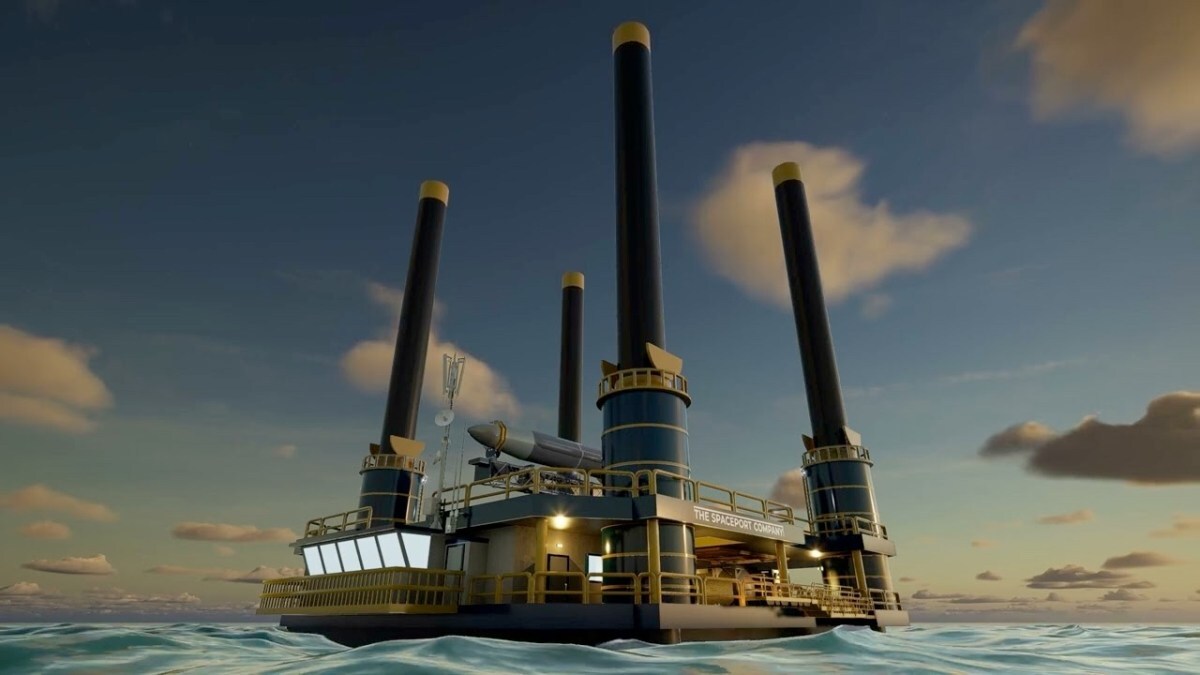28.02.2023

The Spaceport Company is working to develop mobile sea-based launch pads it argues can help address congestion at existing launch sites. Credit: The Spaceport Company
ORLANDO — A startup is proposing one solution to the increasing congestion at major launch sites: build mobile launch pads that operate at sea.
The Spaceport Company is planning to demonstrate a sea-based launch platform in May, conducting four sounding rocket launches from a modified ship in the Gulf of Mexico.
“That will help us prove out our logistical, operational and regulatory procedures,” said Tom Marotta, founder and chief executive of the company, during a panel at the SpaceCom conference Feb. 23.
Those tests will be a precursor to developing a full-scale sea-based platform, based on a ship design called a liftboat. That ship can sail to a location and lower legs to anchor itself on the seafloor. The boat can then lift itself out of the water and serve a launch platform.
The advantage of The Spaceport Company’s concept is that it doesn’t rely on any fixed infrastructure on land: all the resources needed for a launch are on the ship, and the rockets that launch from it would use autonomous flight termination systems that do not require radars or other tracking assets. “What we’re really doing is building a new type of spaceport,” he said. “We’re building a high-cadence, responsive spaceport to solve the problem of spaceport congestion.”
Growing launch activity at Cape Canaveral is threatening to cause problems for launch companies as the pace of activity stresses infrastructure there. New spaceports, designed particularly for small launch vehicles, have run into problems. A proposed spaceport in Camden County, Georgia, took years to secure a license from the Federal Aviation Administration, but in a referendum last year county voters blocked the acquisition of land for the site, a decision recently upheld by the Georgia Supreme Court.
“It’s scalable,” Marotta said of the sea-based approach. “It’s a lot easier to build more ships to meet more launch demand than it is to go find 100 acres on the coast somewhere.”
The initial sea-based platforms the company proposes would operate several kilometers offshore, remaining in U.S. territorial waters at depths up to 60 meters. “We can operate up and down the entire East Coast,” he said, based at any major industrial port. It would host small launch vehicles in size up to Firefly Aerospace’s Alpha, which can place about one ton into orbit.
Unlike ground-based commercial launch sites, The Spaceport Company’s sea-based platforms would not need an FAA spaceport license known as Part 420. “It comes down to how we define a spaceport, which is a fixed location on Earth, and his moves,” said Pam Underwood, director of the FAA’s Office of Spaceports, on the panel.
Both she and Marotta, though, said safety issues would be captured in the separate launch license for the vehicle launching from that platform. “We still meet the same safety criteria as a site with a Part 420 license. It’s just captured entirely under the vehicle license,” he said. “We are just as safe and just as sustainable.”
Sea-based launch is not a new idea. The multinational Sea Launch venture conducted dozens of launches of the Zenit-3SL rocket using a converted oil rig before being sidelined by financial and geopolitical problems. More recently, China has demonstrated the use of converted ships as launch platforms for small vehicles.
SpaceX acquired two oil rigs it renamed Phobos and Deimos with the intent to convert them into offshore launch platforms for its Starship vehicle. However, earlier in the month Gwynne Shotwell, president of SpaceX, revealed that the company sold the rigs after concluding they were “not the right platform” for them, but added that the company likely, in the long term, will use sea-based platforms for the vehicle.
Marotta said The Spaceport Company will soon announce “deepening partnerships” with launch providers. It has a memorandum of understanding with Virginia Space, which operates the Mid-Atlantic Regional Spaceport at Wallops Island, to study how the company’s platforms could be used to augment the spaceport’s existing launch facilities.
He said he hopes those partnerships along with the demonstration launches in May will help it raise money to build the platforms, which could be ready to enter service as soon as 2025. “It’s a non-trivial amount of money,” he said of the funding his company is trying to raise, but was not more specific.
Quelle: SN
